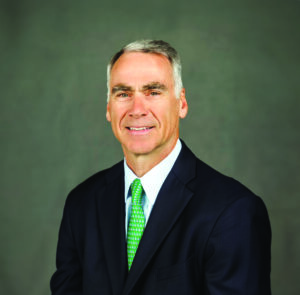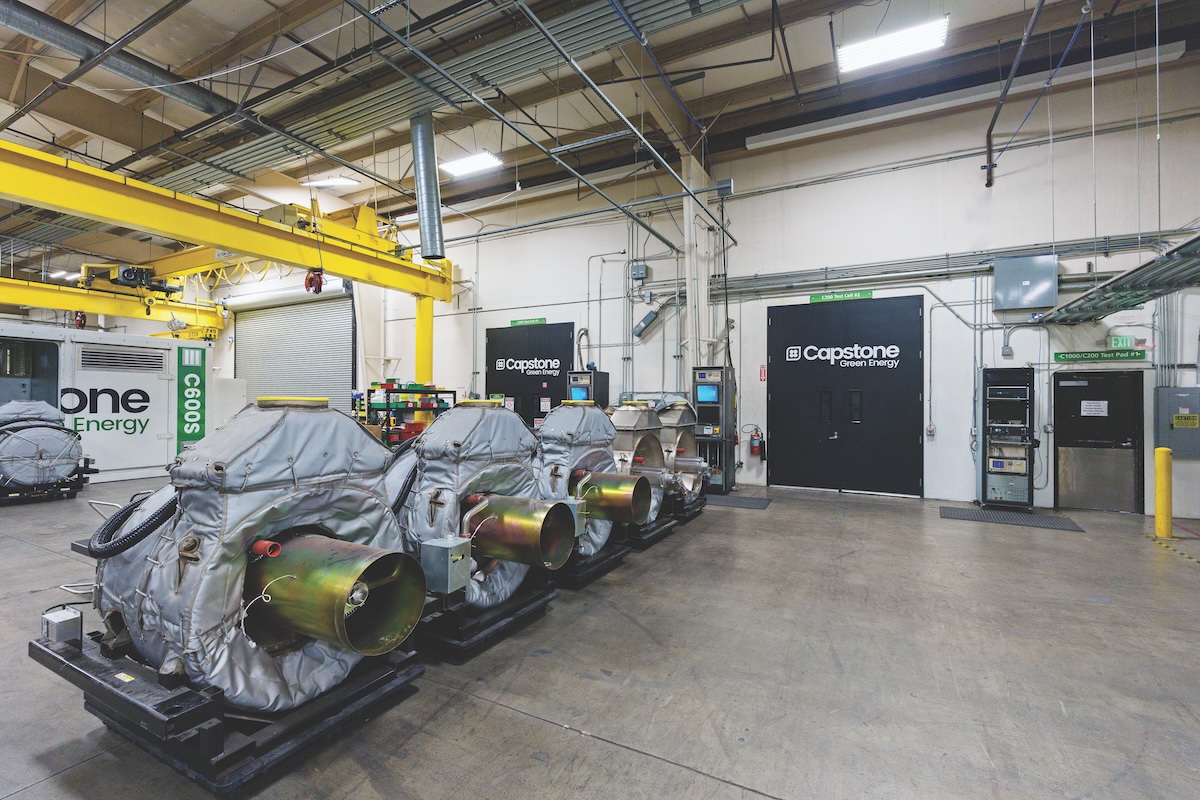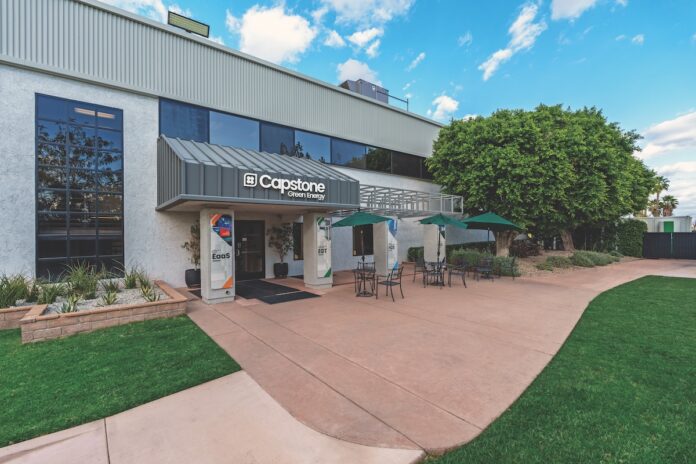This article has been revised and corrected from the original version.
Newly emerged from Chapter 11 bankruptcy reorganization, Capstone Green Energy Corporation said it is poised to capitalize on current market trends to achieve its goals of profitability while paying down the remainder of its debt.
The Van Nuys-based microturbine manufacturer emerged from bankruptcy on Dec. 7, kicking off a restructuring to streamline its procurement and sales operations, keep up to date with nascent technology and cater to a global market in greater need of energy solutions than ever. In a partial debt-for-equity exchange, Goldman Sachs took on 37.5% ownership of the company. This brought down its $53 million loan to Capstone to $23 million, with a three-year repayment plan. Meanwhile, the Capstone is finishing its restatement of common stock, which comprises the remaining 62.5% of the company, and will relist on the OTC Markets Group. After initially anticipating $5 million in new money, Capstone ultimately emerged with $7 million in added cash.
 Interim Chief Executive Bob Flexon, who took the reins in August, said Capstone had little choice but to file for Chapter 11 after failing to find a buyer last year.
Interim Chief Executive Bob Flexon, who took the reins in August, said Capstone had little choice but to file for Chapter 11 after failing to find a buyer last year.
“We could see that refinancing the $50-plus-million note was going to be a challenge. And there were various covenants on it, and they were getting tighter and tighter on us. It came to a point where doing nothing was not really an option for us,” Flexon, who is also Capstone’s chairman, said in an interview. “The restructuring actually presented a better alternative, which is typically odd for a Chapter 11.”
No profit in 20 years
Capstone, which was founded in 1988, offers a range of microturbine units designed to use a variety of fuel sources and run as either a stopgap measure or around the clock. Its units use thermal energy fuels such as natural gas, biogas, landfill gas, hydrogen and propane, which emit substantially less carbon than the typical diesel-powered generator.
Since selling its first commercial unit in 1998, Capstone said it has shipped more than 10,000 units to 83 countries. The company also claimed its units have helped customers – typically remote industrial sites such as oil and gas platforms, landfills, agricultural operations, wastewater treatment plants and electric vehicle charging stations – save nearly $1.1 billion in energy costs and reduce emissions by 1.9 million tons of carbon in the last five years. The company typically charges about $1,250 per kilowatt; as an example, the smallest system, which produces 65 kilowatts of electricity, is priced at approximately $81,250.
That said, sales historically have not been enough to prop up its operations, and while the onset of the Covid-19 pandemic certainly did not help, Flexon hesitated to place much blame there. He criticized past layoffs – some of which he acknowledged as happening during his tenure on the board – as ultimately making problems worse because the operations themselves were not altered accordingly.
“I don’t think in 20 years the company has made a profit,” he said bluntly. “I don’t really like to blame Covid. It just kind of made a tough situation tougher. We continued to consume capital and the sales volumes just weren’t high enough to generate a profit.”
Capstone’s most recent financial report showed a $12.2 million loss for the first three quarters of fiscal-year 2023. (That year ended in March, but the company has delayed additional reporting for a variety of reasons.) The company reported a $20.1 million loss for fiscal-year 2022, which followed an $18.4 million loss in 2021.
Post-bankruptcy, the company is forecasting a $2.14 million loss for 2024. For 2025-2027, it is projecting net incomes of $2.78 million, $7.32 million and $10.7 million, respectively.
Success with microgrid
Still, Capstone seems to have found footing in recent years for a successful business model. Its “energy as a service” offering, which distributes microturbine units as long-term rentals and maintains lifecycle maintenance, has taken off substantially since its 2021 fiscal year, when the program secured 7 megawatts worth of units contracted; Capstone contracted 26 megawatts in 2022 and 51 megawatts in 2023, and to date for the current fiscal year has 54.1 megawatts secured.
This model, Flexon said, helps create microgrids, where energy can power key infrastructure in the event that the traditionally centralized power distribution network fails.
“The primary goal of microgridding, at least as it currently exists, is for energy resilience. It’s more for dealing with the effects of climate change rather than the causes,” explained Robert Bikel, director of the Socially, Environmentally and Ethically Responsible Program at the Pepperdine Graziadio Business School. “How do we keep critical infrastructure and remote communities going during an extreme event that would require (the utility company) to shut off power for thousands of residents?”
Flexon cited the more isolated communities in California as one beneficiary of this model and added that tourist-driven islands such as Hawaii and those in the Caribbean are similarly strong markets for Capstone. The market shift to net zero emissions and investment by governments into such infrastructure also provide a significant tailwind, Capstone argues.
“It’s also power generation, but at a very different scale. I do believe the centralized power station is something that is fading away as time goes on,” Flexon said. “It bodes well for Capstone, which can provide local generation. If you have a Capstone unit on your roof, you don’t have to rely on transmission, so it’s a better way to have reliability.”
Prior to joining Capstone’s board in 2018, Flexon was president and chief executive at Dynegy Inc. for seven years. He also currently sits on the board of the Electric Reliability Council of Texas, commonly referred to as ERCOT, and is chair of Pacific Gas & Electric Corp. He succeeded Darren Jamison, who resigned effective Aug. 22 after 16 years at the company. Capstone filed Chapter 11 in a prepackaged plan about five weeks later.
Flexon said he hoped to recalibrate Capstone in many respects, ranging from culture to business practices. This will involve hiring or moving people around, and, in some cases, eliminating roles. This ties in to a simultaneous push to stay more current with technological advancements or combine technologies – such as working with oil and gas companies to capture flare-off gases to power turbines instead.
“I would expect our headcount to increase. We have gaps to fill, and we just have to make sure we have the right people in the right jobs,” he said.
Inventory backlog

The business operation also leaves something to be desired, Flexon admitted – finished inventory often sat on the shelf for nearly a year, the company was behind two years on providing spare parts to some customers and very often it would wait five months to pay its vendors.
Capstone currently has about $25 million in inventory ready to be offloaded, which, if Flexon’s goal of moving product within 60 to 70 days is met, means there is a “significant amount of capital” to unlock.
“We need to get much better at procurement and inventory management. Right now, we hold inventory for 300 days before selling it. That’s a lot of cash just sitting on the shelf,” he said. “We’ve got to re-earn (vendors’) trust. You can’t take your payables to 150 days and expect your vendors to give you the best terms and price.”
Bikel agreed that current regulatory and market tailwinds probably stand to benefit a company like Capstone. While wind and solar, combined with battery storage, take up a lot of the conversation, communities cannot yet rely on that for around-the-clock energy generation. That said, there remain questions as to how to integrate thermal-power generation into a diverse energy portfolio, especially in the long term, because of how expensive microgrids currently are.
“The other challenge with this is these are still really expensive, so you’re stuck with them for a long time,” Bikel said. “One of the barriers to adoption here is the upfront capital cost is still pretty high, so likely the configuration that gets built is one that’s going to be around for a while.
“There’s so many technology considerations and a lot of investment tailwinds. At the same time, the interest-rate environment is terrible for large-scale infrastructure projects right now,” he continued. “The pricing of the components and the rate of decline in battery makes it a little fuzzy to predict what’s the optimal mix for if you’re going to design a microgrid right now.”
